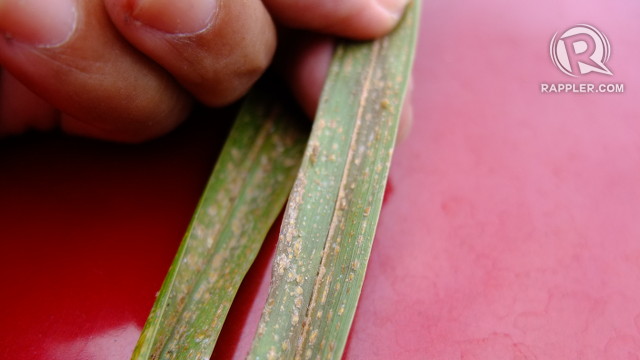SUMMARY
This is AI generated summarization, which may have errors. For context, always refer to the full article.
MANILA, Philippines – The Philippines stands to lose more than P186 million a year in coconut production because of the so-called “Typhoon Yolanda of pests” – the coconut scale insect epidemic plaguing Calabarzon (Region 4A).
The moniker was dubbed during a May 12 Senate hearing called to investigate what has been done to contain the outbreak, which according to government data, has now infested 1,034,342 coconut trees in the region or 1.76% of the total.
This is 20 times more than the number of trees infested in March 2013 – roughly 54,000 trees.
In terms of copra production, the country will lose more than P170 million in annual revenue unless the outbreak is contained, according to the Philippine Coconut Authority (PCA).
The loss is expected to further drive down total Philippine coconut production.
According to the Food and Agriculture Administration (FAO), the country has already slipped from its position as the world’s number one coconut producer.
From holding the spot with 19.5 million metric tons (MT) of coconuts in 2010, it dropped to second place with 15.9 MT in 2012. Indonesia was that year’s top producer with 18 MT.
Around 330,000 coconut farmers have been affected by the outbreak. This does not include people who work in other aspects of the coconut industry which produces around 30 different products – from coconut sugar to fertilizer.
The outbreak was first reported by coconut farmers in 2009 where yellowing of coconut leaves, a symptom of infestation, was first observed in Barangay Balele, Tanauan, Batangas.
Since then, the infestation has spread to the rest of Batangas, Laguna, Cavite and Quezon.
Formidable pest
The Philippine Coconut Authority disclosed to the public the exact species of coconut scale insect laying waste to the region’s coconut plantations.
“Aspiodotus rigidus is in the Philippines,” said PCA Region 4A Officer-in-Charge Erlene Manohar.
Aspiodotus rigidus is a species of coconut scale insect never before seen in the country. Recent reports tracked the pest in the Sangihe Islands, Indonesia, where it infested mangosteen fruits.
It is a formidable pest for several reasons. First, it is an armored scale species which means the mother is able to protect its young by covering them with a wax tip.
In a severely infested tree, you can find 10,000 females in one leaflet. They have a lifespan of 28 to 32 days during which time they can lay thousands of eggs. What’s more, females can reproduce even without males.
The complexity of the problem prompted Manohar to admit, “There is no such thing as eradication. We can only restrict the spread and damage of the insect. We can rehabilitate.”
The Scale Insect Comprehensive Action Program (SICAP), the task force formed to contain the outbreak, is taking several steps to address this.
Laguna, Cavite, Batangas and Quezon have been put under quarantine with 3 checkpoints monitoring the exit and entry of goods. Coconuts and other products that can host the pest cannot be brought out of the provinces.
The task force, with the help of local government units, plan a “massive application” of green label systemic pesticides through injection into the tree trunks.
They are also collecting special wasp parasitoids found in Mindanao, insects that specifically infect the scale insect.
These are different from the coccinellid beetles they used before. Parasitoids do not eat scale insects but kill them by laying eggs on them. The presence of these special wasps may be one reason Mindanao has not yet been affected by the pest.
Fire trucks will also be deployed to for large scale power spraying of detergent liquid in high-risk areas. Heavily infested trees more than 60 meters in height will be cut down, said Rey Velasco, SICAP Manager for Research and Development.
Too little too late
During the hearing, the Department of Agriculture and PCA were heavily criticized for their slow action in containing the outbreak.
Manohar admitted that it was the erroneous identification of the scale insect as merely a local species that led some scientists and government officials to use the usual measures in dealing with the problem.
“We have to admit we were not ready because we could only handle the local species. Water and soap spray would have normally been enough,” she said.
Francisco Lirio, a former mayor of Tanauan City, where the pest was first reported, said he wrote to DA Secretary Proceso Alcala about the pest on his first week as secretary but got no response.
It was only in 2012, after he had gone to the media, that the secretary himself visited the city to see the dying coconut trees. Alcala was a no-show at the senate hearing.
“You are 3 years and 150,000 trees too late Mr Secretary,” said Lirio. – Rappler.com
Add a comment
How does this make you feel?

There are no comments yet. Add your comment to start the conversation.